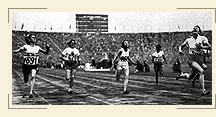|
 The story of a housewife: Fanny Blankers-Koen
The story of a housewife: Fanny Blankers-Koen
The first time Fanny Blankers-Koen met Jesse Owens was during the 1936 Berlin Olympic Games. The 18-year-old athlete had participated in two  events: the long jump, where she ranked sixth, and the 4x100m relay, where she won the fifth place. The most valuable thing she acquired from those Games was an autograph from Owens. The next time they met was 36 years later, in Germany again, during the 1972 Munich Olympics. Blankers-Koen introduced herself to him and referred to the autograph from back in 1936, which she treasured as one of her Olympic souvenirs. Touched, Owens told her that she no longer had to introduce herself. Fanny was not the unknown athlete of 1936, but perhaps the greatest track and field female athlete in the history of the Olympic Games. events: the long jump, where she ranked sixth, and the 4x100m relay, where she won the fifth place. The most valuable thing she acquired from those Games was an autograph from Owens. The next time they met was 36 years later, in Germany again, during the 1972 Munich Olympics. Blankers-Koen introduced herself to him and referred to the autograph from back in 1936, which she treasured as one of her Olympic souvenirs. Touched, Owens told her that she no longer had to introduce herself. Fanny was not the unknown athlete of 1936, but perhaps the greatest track and field female athlete in the history of the Olympic Games.
Francina Ålsje Koen was born on 26 April 1918 in Amsterdam. Her father was a track and field athlete specialized in the throws (the discus throw and the shot put). She, however, had an inclination to the track events (sprints, hurdles) and the jumps (high jump, long jump). To that had contributed her acquaintance with Jan Blankers in 1934, Olympic winner in the triple jump at the Olympic Games of Amsterdam (1928), who became her trainer and later her husband. Two years later, in 1936, she made her first appearance in an Olympic organization. She was just 18 years old and, like an entire generation of athletes, she would have to live through the vortex of war in order to participate again, twelve years later, in the Olympic Games.
During that time Blankers-Koen had participated in the European track and field championship in 1938, the first including women, where she won two bronze medals in the 100m and in the 200m. Two years later she got married, had two children and continued training throughout the German occupation. During those years she achieved her first world records: in the 80m hurdles (1942), in the high jump and in the long jump (1943), as well as in individual and team races in 1944. Therefore, the re-emergence of sports institutions and games in postwar Europe saw Blankers-Koen winning the gold medal in the high hurdles and in the 4x100m relay in the European track and field championship of 1946.
Two years later, in the Olympic Games of 1948, Blankers-Koen was already 30 years old, an age that was considered prohibitive of achieving top performances. What is more, it was deemed inadmissible for a woman to "forsake" the custody of her children in order to engage "half-naked" in sports games. As a result, her participation in the Olympic Games received strong censure, especially in the Netherlands but also in Great Britain. On the eve of the Games she received insulting letters, while the comments in the newspapers were just as mean.
The result of all this was the disproof of pseudo-scientific approaches, but also a strong slap at all those who claimed that championship was incompatible with the chief duties that an adult woman had to fulfil: that of the mother, wife and housewife. Blankers-Koen was the leading figure of the fourteenth Olympic Games. Although she was at the first stage of a new pregnancy, she won, like Owens in 1936, four gold medals in the track events (100m, 80m hurdles, 200m, 4x100m relay), an accomplishment that no other female athlete has been able to repeat ever since. The fourteenth Olympic Games were the triumph of the "flying housewife", as she was named.
|